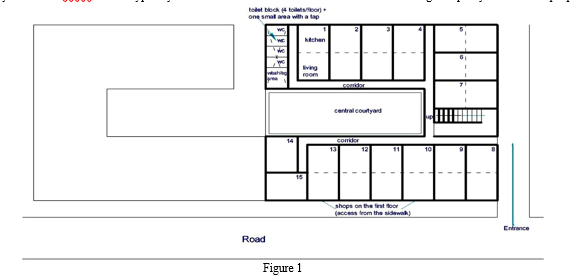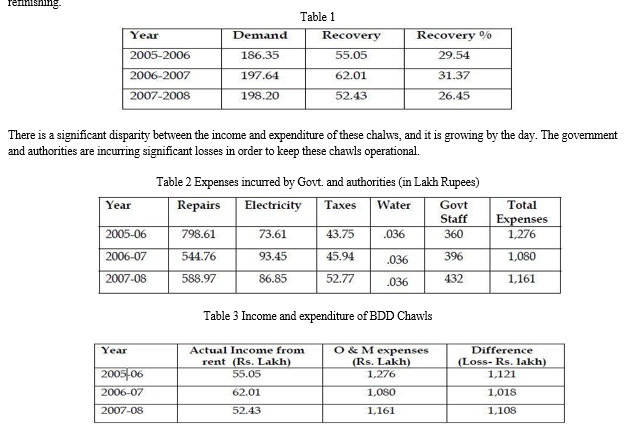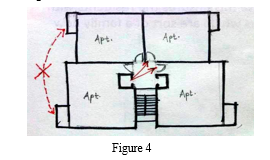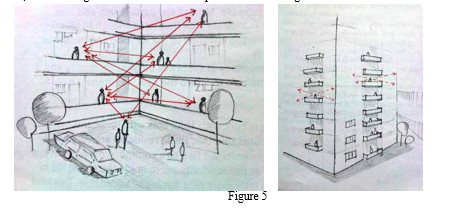Ijraset Journal For Research in Applied Science and Engineering Technology
- Home / Ijraset
- On This Page
- Abstract
- Introduction
- Conclusion
- References
- Copyright
Mumbai Chawls: Resettlement vs. Chawl Culture, and Possible Solutions
Authors: Rupali Gawde, Sachin Paliwal, Nitya Durve
DOI Link: https://doi.org/10.22214/ijraset.2023.54617
Certificate: View Certificate
Abstract
Bombay (Mumbai), the commercial capital of India is a notable example of the similarity and variety that portrays India. As a destination that has always fascinated immigrants, the city has always received individuals from several parts of the country. Migration has led to extraordinary Population growth, with limited space which is leading to excessive profitable exploitation of fabricated environment. Along with this transformation observed in the building commerce, there still occurs a dwelling typology known as “Chawls” – a medium density mass housing. Chawls have deeply rooted their communal culture in Mumbai’s history over the past century. Chawl culture has essentially grown on features like mutual binding, interaction and sharing amongst the residents, Normally occupied by middle class residents, chawls deliver entrance to a variety of services and, most significantly, a social support-system that makes living Easier in present-day Mumbai. This model is developed as basis for sustainable way of life and communal living along with classic low cost architecture that was started in mid-twentieth century. The present situation of these seventy-eighty year old chawls is such that many of them have been stated dangerous and unfit to live-in by the government and further housing organizations. Huge amount of Money spent by the housing authorities and residents to repair old chawl buildings in Mumbai but still 25 chawls collapse each year partly or completely. Municipal or government authorities do plan to evict peoples out of dangerous structures for maintenance or reconstruction but they just Decline. The inhabitants having an unlikely Stubbornness to shift to safer houses and the possible reason will be the authorities’ complete ignorance towards developing housing localities as a communal living space which is one of the important feature of chawls. The \"chawl culture\" is being driven to the brink of extinction by the inclinations of modern living, and as a result, a substantial composite housing pattern of the society is being reduced. Hence, this study concludes with highlighting the urgent need of repair and resettlement of chawls and why chawls occupants are not ready to shift anywhere else and coming up with a solution which will be beneficial for both the development authorities and the occupants of the chawls.
Introduction
I. INTRODUCTION
Bombay or Mumbai, the commercial capital of India is a notable example of the similarity and diversity that portrays India. There were two main aspects that transformed Mumbai in the 19th century. The in the 1st place the opening of theSuez Canal, which reduced the distance from England to India and Mumbai (west coast of India), became a nearer port than the previously main port of Calcutta (east coast of India). The second was the scarcity of textile during the American Civil war which made Bombay the key exporter of textile to England. Raw cotton produced in inland areas came to Mumbai for trade. As the seaport stretched out, more occupation chances developed. The sum of textile mills in Bombay also increased. The incomes from the textile division were put into other businesses like food processing, medicines and small and medium sized industries. This fascinated a huge number of people belonging to different social group from the countryside areas to seek livelihood in this ‘city of dreams’. The city had a distinct emigrant working class. A distinctive residential feature of the working class of Mumbai was the well-known ‘chawl’ which accommodated a major section of Mumbai’s population.
A. Evolution Of Chawls
The origins of chawls are not clear, chalws seem to be related to old-fashioned Indian courtyard housing and wadis transformed over time to the urban circumstances of Mumbai. These wadis have some basic similarities to chawls i.e. the rooms are organized along a shared corridor with toilets outside the living areas by tradition, one joint family used to live in individual wadi but progressively as the populace of Mumbai in the early nineteenth century, different rooms were occupied by different families the typical old style of Bombay houses began to disappear and in response to the ever-growing demand for housing, constructers divided the houses into many small cubicles without any consideration for light and ventilation. So it seems plausible to read chawls as an urban equivalent of the rural wadi house form. It is still unclear that when chawls, began to be built in Mumbai.
By middle of 18th century. britishers allot plots to the people who wished to build and live in Mumbai, leading to a rapid increase in no. of persons who bought plots in the city. It is likely to conclude that even though the housing sector took off in the 18th, the number of chawls built quickly increased after the 1860s. Largely, it can be concluded that chawls in the city of Mumbai were adapted from the rural wadis, due to the increasing pressure to accommodate residents. Many chawls were built in the course of the British Raj either by the government or private land owner. Most of the chawls were built after the industries especially textile industry, as seen previous, the growth of industries and the rise of diverse socio-economic classes had a huge effect on the three-dimensional development of Mumbai. Thus it can be said that, chawls do play an important part in the progress and urbanization of Mumbai.
B. Chawls In Present-Day Mumbai
Currently, Mumbai is home to many chawls that lack proper sanitation, are physically unstable, and pose a risk to occupants. for examples a hundred-year-old chawl buildings in the old Mumbai where the Housing Authority had planned to shift all families because the chawl buildings had become structurally weak. The inhabitants as having an unlikely stubbornness to move to safer homes” despite the buildings condition. For example of a family that moves to a newer apartment from a chawl provides potential vision of this resistance. That the elderly woman of this family “feels suffocated” and misses the chawls after shifting into the apartment building. To understand why people do not want to move out of dangerous situations and why they miss these places when they do move is central to this project. To better such issues, we have to understand the Connection between the chawls and their inhabitants completely.
II. BUILDING DESIGN OF A CHAWL
The basic room in a chawl comprises of an average size of 10’ wide and 12’ -20’ in length unit, the passage in the front of the house provides the entry doors to the units. The passage in the back provides a passage to shared sanitary facilities that are shared by the units on the floor. A usual apartment in a Chawl consists of one all purpose room that works both as a living and sleeping space, and a kitchen that also serves as a dining room.
Every room has small space at upper floor to keep extra luggage also serve as a bedroom in some cases, to give them some degree of privacy. The basic chawl unit has typically altered over time due to demand to meet the increasing occupancy and needs of people.

The notable architecture element of chalws are:
A. Courtyard
the most commonly found feature in chawls typology. The well-designed proportions of courtyard sizes with the building height give sense of scale to users for appreciating the space.
These are most interactive spaces in chawls serving multiple functions. It can be noted that the structures sitting is similar that the courtyard is always the core of all social gatherings and functions. It serves as a well-deserved open ground for such dense housing schemes. Courtyards are found to be in various sizes and are generally rectangular. A favorite pass time, game of “box cricket” is played in such area.

B. Verandah & Balcony
The chawls were designed with corridors on the external fringe and the residences within in utmost cases. The dormitory style living is penetrated by these corridors, generally known to be balconies. The Verandah in traditional houses is the inviting space in front of the house. Some chawls have bigger balconies which serve the binary use of a welcoming area before entering inside the house. It can be noticed that more than just the circulation space between the areas of surrounding these spaces have evolved over a period of time from being the buffer zone of a chawl unit into an extended house, it encourages the idea of living together as family with neighboring units.
C.Chowk
A key location for social interaction is a central point or crossroads created by gullies and major arterial highways. The activities connected to this node can be extended across the entire neighbourhood. It has been noted that these intersections provide access to local transit as well as essential facilities including post offices, clinics and community centres. One of the most significant components of socialist historical movements can be ecognized to be these crossroads.
D. Gully / by-lane
Along with the chawls, a small roadway is a crucial component of the chawl neighbourhood. These join the two chawls together. It should be mentioned that the Gulllies have stores, launderettes, a wheat mill, etc. that are connected to essential services for customers. Additionally, it has been noted that locals operate the stores as a secondary source of income.
E. Nukkad
Nukkad is a term for a less obvious juncture when smaller gullies are connected. It has been observed that these street corners typically have a tea shop, a newspaper kiosk, or seating areas built beneath a tree. This is connected to a shared recreational space among the chawls.
These settings make a beautiful backdrop for festivals and other cultural occasions.
III. WHY IS THE CHAWLS’ RESETTLEMENT NECESSARY?
The majority of the chawl buildings are found in the centre of Mumbai, an island metropolis, and they are all nearly 80 years old. The life cycle of these chawls is complete.Buildings’ external infrastructure, including the sewage system, storm water drainage, and water supply, has deteriorated and need replacement immediately. Chawl buildings’ general state is declining, and they might not last very long as things stand. The inadequate and increasingly expensive building maintenance is one of the contributing factors. The authorities are unable to recover even half of the incredibly cheap rent levied. Major repairs couldn’t be made as a result through the government.. In the past 80 years, the area’s land value has increased astronomically. As a result, it is impossible to describe the existing usage of land as efficient and ideal..

Consider the 207 chawls buildings constructed by the Bombay Development Department (BDD) within the regions of worli, sewri, naigaon, and NM joshi marg. These buildings were completed between 1920 and 1930, and as of today, nearly all of them have reached the end of their useful lives and are becoming more and more structurally unstable. The life of the buildings' occupants is in danger because of their structural and physical state, and 4 to 5 structures collapse completely or partially each year.
Chawls have many structural issues resulting from their ages and lack of maintenance like columns are damaged and reinforcement is exposed and corroding ant many places, stairs and railings are damaged and need urgent repair and refinishing.
Many of the original timber ceiling joists in the Naigaon chawl, for example, have been replaced with steel sections. In some places, steel W-sections are used as additional columns. These structural additions were the result of 'strengthening' work done by an engineer ten to fifteen years ago when cracks were seen in the original timber columns and beams. Use of different materials to maintain the buildings over time, create differences in stresses, elasticity and strains and between the new and the original material, reducing overall structural strength. The current condition of the building is uncertain.
Due to their age and lack of maintenance, chawls have a number of structural problems, including damaged columns and reinforcement that is exposed and damaging in various locations, as well as staircases and railings that require immediate repair and refinishing.

Because of the following reasons the govt. and the authorities plan to evict all the tilize out of the dangerous buildings for repair and reconstruction but the occupants simply refuse to move the authorities describe the residents of having unbelievable stubbornness to move to safer place.
The point was asked as to why residents do not leave the chawls because they can be dangerous. This raised new questions, such as: if the residents have lived there for many years, what are the benefits and drawbacks, what are other housing options for the residents, and how has the building form supported their lifestyle, as well as how has this housing type affected the overall urban fabric in Mumbai.
IV. WHY DO PEOPLE SELECT CHAWLS?
Despite issues with developing infrastructure, the residents of the chawls desire to stay put and do not want to move because of location, close-knit community social support systems, and affordability. This serves as another example of how Mumbai’s historical spatial and social clustering has evolved into the present, providing opportunities for the middle class to live in an economically and socially sustainable manner despite the dissolution of the caste system and the rising cost of living in the heart of the city.
A. Location
Most of the chawls are within walking distance of daily amenities. The distance between hospitals, parks, and theatres is too short. In addition, students can walk to school, and adults who are going to their offices can stroll to the rail and bus stops. The majority of the chawls are well connected to most regions of Mumbai by public transit, and almost all of the residents use it on a regular basis. Residents don’t need to leave their homes for daily activities because the majority of internal streets in the neighbourhoods contain grocery stores and other general establishments to meet their needs. Numerous stores accept phone orders and deliver products right to customers’ houses. This convenience is not usually available in Mumbai’s other neighbourhoods because of the city’s strongly segregated commercial and residential sectors.
For a variety of reasons, the occupants are physically and emotionally devoted to the chawls they call home. For this income range, the majority of the larger apartments in Mumbai and its suburbs are out of reach. Prices are now out of reach for the average person. Even those deeply tucked away in the suburbs are out of the price range of the middle class. Other, larger apartments can be available in Mumbai’s suburbs, where it may not always be convenient to walk to work. For residents, it would be quite challenging and time-consuming to commute daily to and from these regions, which would increase their transportation costs. The participants highlighted that due of the convenience these areas provide, they would never leave them. Thus, it can be determined that one key factor in explaining why people haven’t relocated to other areas is the chawls’ position within Mumbai.
B. Affordability
The chawls’ residents choose to live there because of the affordable housing options and convenient location. The locals have a very tough time affording any other apartment-style accommodation in the same areas. The chawl is located in a region where factories and mills were built in the nineteenth century. Developers have been transforming mill site into offices, theatres, shopping malls, and other structures since all of the mills shut down in the 1980s. The skyline in this neighbourhood is changing drastically as a result, and tall, multistory apartment buildings may be seen close to historic chawls. In comparison to many other areas of Mumbai, these areas also have high property prices, and many new high-rise structures have replaced many of the city’s older structures.
This current urban layout also indicates that Mumbai’s 19th-century urban fabric is rapidly changing. Currently, rent for a 750 square foot apartment in Parel, a neighbourhood near Naigaon, is rs 25,000, and rent for a 600 square foot flat in Grant Road is rs. 35,000.This demonstrates that the low-income middle-class chawl residents, who pay just approximately Rs. 250 per month in rent, would not be able to afford living in other apartments in the same area and that, as of today, chawls are their only affordable housing alternative. Thus, it can be claimed that one of the key reasons why residents have not left chawls is the importance of location. The proximity and ease of access to amenities, transportation, and shopping reduce people’ dependence on transportation, which is extremely sustainable.
C. Chawl culture
Residents of are highly regarded for their lifestyle, culture, and viewpoint on life. They take pleasure in each and every minute of life. Both in their homes and in their minds, there are no restrictions. They are tied to one another like a large family and are always there for one another in good times and bad. Love, laughter, hope, and amazing space management are all present.
There are often idols and pictures of God present, as well as a washing machine, 165-liter refrigerator, television, music system, and even a wall-mounted foldable dining table in many of the residences. Because tenements are so small, it is challenging for the occupants to spend the entire day at home alone. They primarily tilize their home for sleeping, eating, and bathing. They spend the rest of the time outside of the house. Age-based groups are thus created, and each group has a designated meeting spot. Half of each day is spent with friends when on holidays or vacation. They are tied to one another like a large family and are always there for one another in good times and bad.
D. Lifestyle
People living in a Chawl have little privacy. Because of the close nature of the quarters, minor news and gossip travels quickly. On the other hand, however, this close living situation also leads to a friendly atmosphere, with is backing networks akin to familial relationships. There is more togetherness, cooperation and help. If male had to go out of Mumbai or a family member was admitted in hospital, one need not worry about home. Neighbors would look after children, and food was never a problem. Someone is free to attend hospital or be with you only to give company and courage. Somehow amount of money needed for treatment was arranged. Nearly everyone was invited to attend marriage. Everyone in your Chawl knew practically everything about you, your extended family, and your guests.
E. Peoples
People from all different backgrounds coexist in the chawl, develop together, and form close bonds with one another. They stick together through good times and bad like a large family. People can be found chatting, playing with their kids, and developing romantic relationships in the “chawl” area.
The locals come from the middle class. Typically, men are the family’s income producers and women are housewives.
F. Cultural activity
In all the social and economic movements that have impacted the lives of people in Mumbai, the Chawl has been extremely active and dynamic. This encompasses Mumbai’s festive spirit throughout the year, such as at Govinda (Gopalkala), Ganeshotsav, and Divali (Dipawali). In the wadi, there is a Mandal where everyone comes together to celebrate.
In an interview with the resident of chawls who is living in chawl for last 25years he share his experience.-
"I've been living in a chawl for a long time.. Our doors are always open for neighbors even late at night, if there is an emergency. The neighbors are part of our family.” When he was asked “Would you like to shift to a self-contained flat?” He replied,”Anyone who has lived in a chawl will never wish to shift anywhere. We celebrate all our festivals, puja and other cultural activities together.
People in apartments don't even know who their neighbours are! Some residents, however, feel the urge to upgrade to a self-contained unit. But here there is a culture of sharing food, even if it is just from a small bowl so we are happy with our big family”


Conclusion
According to the observations made above, the interaction between people was spurred by the compact and densely packed housing. The family was divided into categories that defined the locations they used during the day, ranging from the elderly to the newborn. It was discovered that the chawls operate as a coordinated network of places and as such. Sometimes the pieces come together to form a whole. The chawls can be roughly divided into two categories: the modest private unit and the remaining multipurpose and communal areas. With the expansion of the family, there is a noticeable change in the way space is used. The portions that were previously unusable or assigned a different use have been renovated or transformed into usable additions. In modern housing, \"floor space is typically dedicated to achieve a maximum of pure dwelling-unit floor space\" and is not used for communal areas that foster neighbourly connections. These interactions are made possible by the typical chawl arrangement and, on the other hand, prevented by the typical apartment block configuration..The chawl residents enjoy the usual chawl design and ambiance. They won\'t enjoy living in an apartment complex because it will give them greater privacy at the cost of social interaction. The resettlement buildings offered to them should be in the same area and free of charge on a completely ownership basis. And instead of providing regular apartment buildings, they should provide structures that closely resemble chawl designs, have all the necessary features, and do along with their drawbacks to provide better living conditions.
References
[1] N. Adarkar. The Chawls of Mumbai: Galleries of Life. Imprint One, 2011, p. ix. [2] Jan Nijman, “Mumbai’s Mysterious Middle Class.” International Journal of Urban and Regional Research 30/ 4 (2006). [3] Manu Joseph. “How Many Legs in A Square Foot?” Outlook India, 18th August 2003. [4] http://www.outlookindia.com [5] Smruti Koppikar. “Thereby hangs a storey.” Outlook India, 12th September 2005. [6] Rohatgi, Pauline, Pheroza Godrej and Rahul Mehrotra. Bombay to Mumbai: [7] Changing Perspectives. Mumbai: Marg Publications, 1997. [8] BDD Chawls – Survey, Findings & Redevelopment Strategies by Mumbai Transformation Support Unit- Aug.2009 [9] Edwards, S. (1909). Gazetter of Bombay City and Island. Mumbai: Cosmo Publications. [10] Sinha, S. (2001). Discover Mumbai-The city\'s history and culture redefined. Marshall Cavendish Corporation
Copyright
Copyright © 2023 Rupali Gawde, Sachin Paliwal, Nitya Durve. This is an open access article distributed under the Creative Commons Attribution License, which permits unrestricted use, distribution, and reproduction in any medium, provided the original work is properly cited.

Download Paper
Paper Id : IJRASET54617
Publish Date : 2023-07-05
ISSN : 2321-9653
Publisher Name : IJRASET
DOI Link : Click Here
 Submit Paper Online
Submit Paper Online

